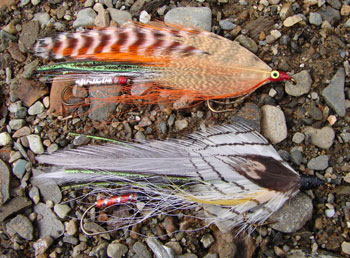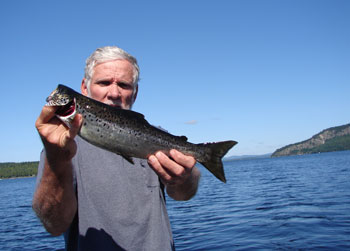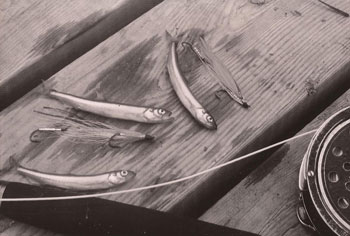Maine’s Legendary Streamer Flies: Useful Works of Art
by Tom Seymour

Streamer flies Pink Lady top and the famous Gray Ghost. Compounded of feathers, hair, tinsel and thread, streamer flies have a long history. A certain type of streamer, developed by Maine fly tiers, began with the advent of the outboard motor in the second decade of the 20th century. Tom Seymour Photo
Streamer flies, lures compounded of feathers, hair, tinsel and thread, have a long history. But a certain type of streamer, developed by Maine fly tiers, owes its beginnings to the advent of the outboard motor.
Early streamers were meant mostly for casting to trout and salmon in rivers and streams. Some were used in lakes and ponds for spiny-rayed species such as bass and pickerel. Trolling, as it exists today, was not practical. Some may have attempted to troll with their sailboats and others paddled canoes while allowing a fly, baitfish or other lure to trail behind. But steady, methodical trolling was not possible.
These first streamers were mostly meant as attractors; they were generic in design and did not imitate anything particular in nature. Tied on single, long-shanked hooks, early streamer flies were usually over-tied, meaning that rather than being sleek and trim, they were rather fat and lumpy.
Outboard Debut
By the end of World War I, a new sound reverberated across Maine’s sprawling freshwater lakes, echoing through pine-studded hillsides and valleys. The age of the outboard motor had arrived.
One-cylinder, with reed-valve carburetors, heavy, cumbersome and not very powerful by today’s standards, these early motors changed the face of trout and salmon fishing in Maine and elsewhere. Now, instead of facing the tedium of rowing or paddling for hours on end, people could simply pull a starter cord, sit back and let the motor do the work.
It didn’t take long for fly tiers to recognize that here, was an effective means to deliver realistic baitfish, specifically smelt, imitations to waiting trout and salmon. In early spring, not long after ice-out, schools of rainbow smelt follow the contour of shorelines, seeking entrances to brooks and small streams. There, they queue up for the annual spawning run up their natal brooks. And waiting just off the mouth of these brooks, lie hungry trout and salmon.

Salmon, Moosehead Lake. Maine has contributed much to the world of recreational fishing for salmonids. The classic streamers, though, seem to me the crowning glory of a fishing-oriented people living in a state that to this day has the natural resources that are the envy of the rest of the country. Tom Seymour Photo
Masterful Illusion
In addition to fish waiting near stream and river mouths, salmon and trout also cruise somewhat blindly in search of smelt. Salmon, in particular, often bite in the middle of the lake, not just along shorelines, although shorelines are the prime territory just after ice-out. Maine fly tiers saw that a realistic smelt imitation, if presented correctly, could prove deadly in early spring. The question remained as to how to design this be-all to end-all lure.
It seemed obvious that the old method of casting and retrieving flies was not very effective. This was due not only to the ungainly appearance of the early flies but also, the speed with which the fly moved through the water. Let’s consider these two factors and see how to deal with them.
First, smelt are long and thin. Even the longest hook of the time was barely sufficient to match the length of a smelt. And those overdressed flies were just too big around and also, too short. That could be resolved by a change in design. Longer, sparser flies would more closely resemble a smelt. The next question was how to make the flies longer.
After that, even given that flies matched smelt in length and overall shape, what was the best method to present them? Outboard motors solved that problem handily. Smelt often zip along at a fast clip and salmon and trout are used to seeing long, thin baitfish passing by at a fairly fast rate of speed. Pulling a fly behind an outboard-powered boat would make it simple to create the illusion of a speeding smelt. And illusion was key. Even if a fly looked nearly exactly like a smelt, a close look at slow speed would reveal its true identity. So move the fly fast, don’t allow fish a close inspection. Appeal to the strike instinct. That, in a nutshell, was the solution.
However, the problem of length of fly remained. This was finally solved by linking two hooks together, in tandem, with a short length of wire. In this way, when tied with longer-than-normal wings (feathers were and are primarily used to create wings in these classic designs), the back hook would grab into fish that slashed at the fly from behind. All problems solved.
Pattern Variety
And boy did this work out well. People began taking fish in previously-unheard of numbers. In time, fly tiers created more and more patterns, each distinctly different from all others. The well-versed salmon and trout fisherman knew to carry a selection of different smelt patterns. If fish ignored one, they might well go after another. And that remains as true today as it did in 1920.
Soon, names of certain Maine fly tiers became preeminent. The likes of Herbert L. Welch, Carrie G. Stevens, Bill Edson (Edson devised a yellow-winged fly using dyed calf tail) and A.W. Ballou (Ballou tied a streamer using feathers from a marabou stork) gained worldwide fame for their creations. But one name stands above all regarding the development of classic streamer flies. That person was Carrie Stevens.
Stevens, the wife of a Maine guide, taught herself how to tie flies and one of her creations won her second prize in a Field & Stream fishing contest. Stevens caught a 6-pound, 13-ounce brook trout on a fly of her own design. People immediately clamored for copies of the new streamer, launching Stevens’ career as a fly tier.
The fly was the now-famous Gray Ghost. The style of tying evolved somewhat from the original that caught the big trout. Stevens added more adornment and also, developed her trademark style of setting the wings parallel to the body, rather than above it. This resulted in the wings partially obscuring the body and while it sounds like a trifling difference, it presented a major challenge to those who would try and imitate Stevens’ pattern. This style of dressing became known as the “Rangeley style.”

Tandem hooked flies imitate smelts. Smelt often zip along at a fast clip and salmon and trout are used to seeing long, thin baitfish passing by at a fairly fast rate of speed. Illusion is key.
Stevens differed from other tiers in that she never allowed anyone to watch her tie. Again, she probably realized that adding this cryptic element to her persona would help boost her appeal and thus gain her more business. Then again, perhaps she simply didn’t want anyone else to learn the intricacies of tying in the Rangeley style.
At any rate, the fly that Carrie G. Stevens first produced on July 1, 1924, has endured to this day and most astounding, it still catches fish as well as it did 91 years ago. We cannot say the same about many other flies and fishing lures because a great many new introductions have their heyday and then gradually fade. This may be because fish get used to seeing them and no longer exhibit interest, or because anglers, constantly seeking that new killer offering, stop using them. Or perhaps it’s due to a combination of both.
But the Gray Ghost, as well as so many other venerable Maine streamer patterns, have a dedicated following and it seems unlikely that they will fall from favor any time soon.
Here is a partial list of some of Maine’s classic streamer flies: Gray Ghost, Black Ghost, Pink Ghost, Silver Ghost, Ballou Special, York’s Kennebago, Edson Tiger Light, Edson Tiger Dark and Pink Lady.
As mentioned earlier, these flies are either tied on a single, long-shanked hook or in tandem, with front and back hooks attached by means of a short length of wire. An old but effective way to fish these, one that not many employ today, involves fishing a tandem streamer on the end of the leader, with a single-hook streamer fastened to a dropper line perhaps three feet ahead of the tandem. This may suggest a small school of smelt. But no matter what fish take it for, it works.
Streamer fly fishing, like so many other things that rely upon natural cycles, has a brief annual window of opportunity. It begins with the first, tentative smelt runs shortly after ice-out and lasts perhaps three weeks. After that, as water warms and smelt discontinue their runs, trolling near the surface with streamer flies becomes far less effective. But even so, on a cool, showery day in summer, salmon often become active near the surface and gladly respond to trolled streamer flies.
Maine has contributed much to the world of recreational fishing for salmonids. The classic streamers, though, seem to me the crowning glory of a fishing-oriented people living in a state that to this day has the natural resources that are the envy of the rest of the country.
